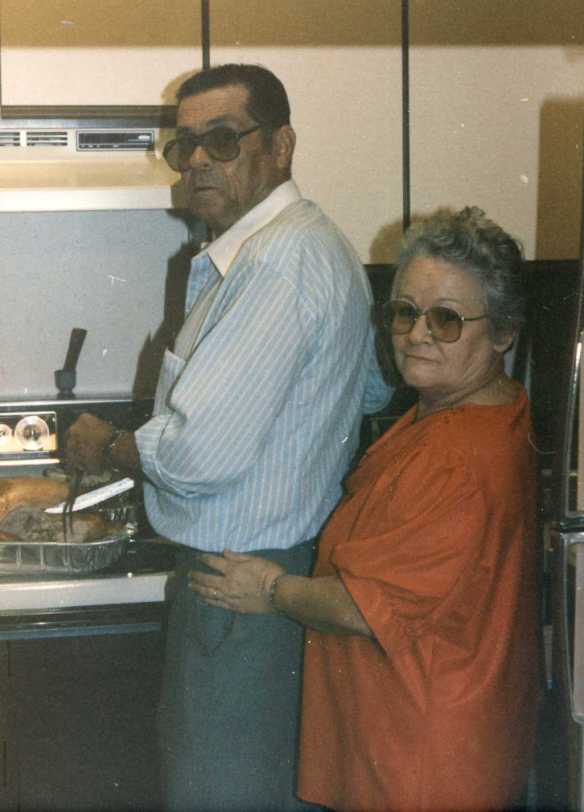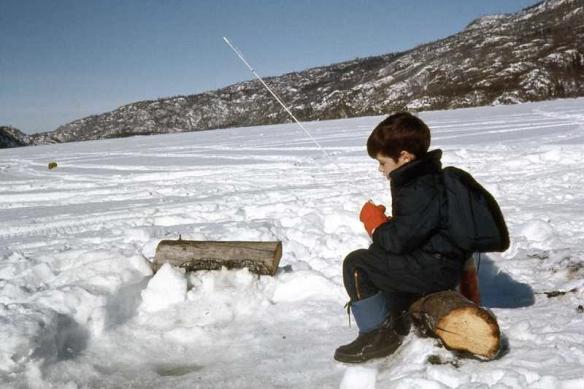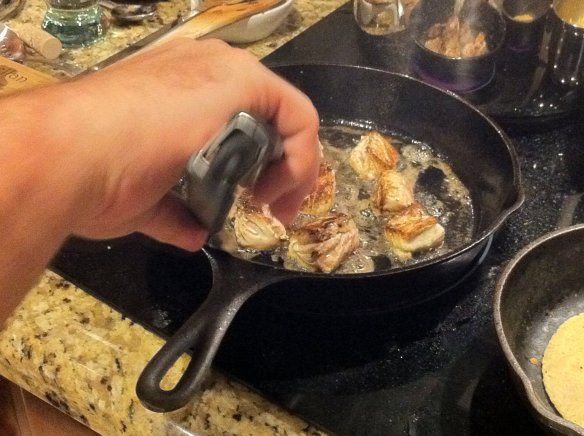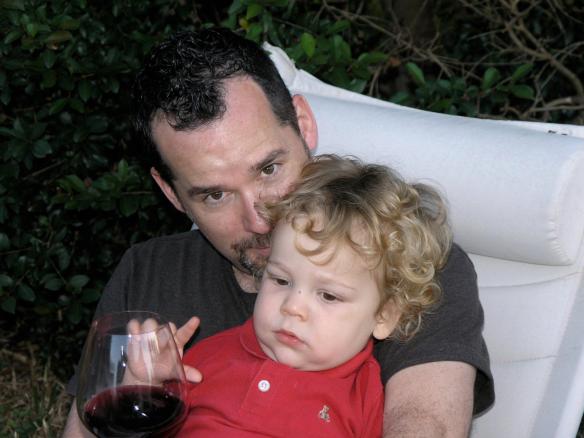Texas Hill Country. Beef and pork, brisket and ribs. Undulating landscape, green and brown, and blue skies full of cotton-white clouds. A van full of people hailing mostly from Texas, with some Canadians, a Colombian, and me thrown in. Political leanings vary, though Democrats (Liberals) outnumber those of less lofty persuasion, and when the conversation turns to the Trayvon Martin/Zimmerman trial and women’s reproductive rights the van suddenly becomes a rolling (and roiling) marketplace of ideas.
But we are here for barbecue, not debate. (Unless it’s debate about the meat.) Texas barbecue. It’s Colby’s birthday weekend, and a dozen or so of his friends have gathered in Austin for a Man Up Barbecue tour, which will also take in a few wineries.

A room fit for barbecue aficionados. (Photo courtesy of Hotel San José)

Muted colors and tranquil paths welcome guests to the hotel. (Photo courtesy of Hotel San José)

A walkway at Hotel San José is bathed in sunlight. (Photo courtesy of Hotel San José)
We gather on Friday afternoon at the Hotel San José, a great little place to stay on Congress Avenue, complete with a small concrete swimming pool, excellent music (Gram Parsons, Buck Owens, Emmylou Harris, Jimi Hendrix) and comfortable rooms. Some might find it a bit pretentious, and the average guest does try diligently to exhibit the proper sense of cool, but the beer and cocktail list is more than ample and the customer service friendly and professional.
Colby had arranged a dinner that evening at Parkside Restaurant, so we get two cabs to take us to the location, a few miles away. Sweetbreads, heirloom tomato salad with compressed watermelon, seared sea scallops, great cocktails. I differed with the sweetbreads: They were too chewy, and I will venture to say that the cook had not prepared too many sweetbreads before he plated mine, but it was not a wasted evening, because the rest of the food, including oysters, was more than passable.
All was well on this first night of the weekend Birthday Bash, but that was soon to change. We left the restaurant and hailed cabs, and as I slid into the back seat I heard a yell and turned to see Angela fall with a thud: She had stepped off of the curb and had not counted on a gutter with a long and steep downward grade. Sprained ankle was the diagnosis. We sped back to the hotel and bandaged and iced her ankle, which was swelling rapidly. (Thanks to the ministrations of Dr. Catalina Sanchez Hanson, Angela was well on the way to recovery later that evening.)

Angela sits at the tasting bar after an unfortunate fall in Austin.
The next morning we assembled outside the hotel, coffee (and in some cases, beer) in hand, ready for the van and the ride to barbecue. I carried Angela piggyback-style down the stairs of the hotel and we were on our way. (That was the first stage of Angela’s assisted tour … a few of us took turns conveying her to and from the venues, which included a fairgrounds, where we wagered on some horses, and where one of us turned a $15 bet into $198, a peach store run by a family of farmers, and a general store/liquor emporium where we sampled some tequila, wine and beer.)

A few hours at the races: Cal’s lucky ticket. (Photo courtesy of Cal Lacasse)

A historic spot, full of beer, wine and tequila and bourbon. (Photo courtesy of Colby Walton)
To the barbecue, the main reason for the weekend. For lunch we stopped at Cranky Frank’s, which is in Fredericksburg. It serves up brisket and ribs and chicken in a small restaurant with eight tables in the dining room and a long picnic table outside. The pit is in an adjacent building, and the smoke that greeted us as we exited the van was a great introduction to the day’s dining. Drew Thornley, one of the men behind Man Up Barbecue, arranged our orders, so all we had to do was wait patiently outside at the table for our meat. (Some of us had already procured beer from Cranky’s, so the wait was more than satisfying.) The brisket here was the highlight, at least to my taste, but a few of my fellow travelers loved the sausage. Sunny day, a crowd gathered around a picnic table, and smoky meat … nothing else is necessary.

Colby brings the brisket.

Our meat awaits, and it was good.

Slicing the brisket at Cranky Frank’s: Great things come to those who wait.

The birthday boy shows the rest of us how to eat ribs at Cranky Frank’s. (Photo courtesy of Ronnie Packard)
We loaded ourselves back into the van and headed for our next stop, the Stone House Vineyard. It was the second winery, and the best one … mainly because we had a rather unfortunate and rude encounter with the owner of the first winery we visited. Seems that she expected those of our party who were responsibly imbibing beer to see the invisible sign stating that beer was not permitted on the premises. Instead of politely asking her guests (and prospective customers) to finish our beer in the van, she demonstrated considerable ire, in the process transforming our visit to her establishment into something odious and uncomfortable. Needles to say, I purchased none of her wines.
Back at Stone House Vineyard, we gathered at a long table in the elegant yet rustic tasting room and sampled five or six bottles of wines made in South Africa. All decent, all certainly drinkable, if unremarkable. Stone House does does produce one wine made from Norton grapes grown on its property, and it was certainly worth the taste.

Bottles, friends, sunny afternoon, all at the Stone House tasting room. (Photo courtesy Colby Walton)
We had before us the highlight of the day, though those of us who had never darkened the doors of Opie’s Barbecue were blissfully ignorant of what lay ahead. As dinner time approached we rolled into the parking lot of Opie’s, having been told what was expected of us, which was to walk through the doors and immediately turn our attentions to the giant black metal container into which meats of all sorts were being loaded, including sausages containing cheese and jalapeño peppers, beef ribs (both spare and short), chicken, and brisket. Oh, that brisket … Kristin and Todd Ashmore have their hands on one talented pit master.
Drew had arranged Opie’s feast, and all we had to do was tell the meat attendant what we wanted and watch him arrange our selections in a tray. That, and graciously accept the cans of Fireman’s #4 and Tecate that were offered. Angela and I chose a little of everything except the chicken, and our barbecue then disappeared into the kitchen, where it was trimmed and wrapped in butcher paper. We walked over to the long counter and waited for our dinner, all the while admiring the desserts – banana pudding, carrot cake, peach cobbler – and taking in the crowd. The place is huge, and it was full of hungry people.

Look at that char: Brisket at Opie’s.

Food with a built-in handle: Ribs at Opie’s.
We again found ourselves at a long table, and set to unwrapping our bounty. The brisket was my first choice, and it was nearly perfect: beautiful char, a slight spicy undertone, wonderful bouquet – think espresso and very faint vinegar. My only criticism was that it was a bit too moist, the tendrils of the meat approached something I could term “soft,” as opposed to tender. Minor quibble, however. This brisket was beautiful, and as I chewed I looked around the table at my happy companions and we silently agreed that all was well. Drew was high on the sweet-and-spicy baby back ribs, which were quite good, and I was enjoying the tater tot casserole and spicy creamed corn. We ate well, had some leftovers, which I wrapped anew and the next morning gave to the room attendant at the hotel, who said he had not been to Opie’s recently and would look forward to a great lunch. The carrot cake and banana pudding ended the meal, and we paraded out to the van, ready for the ride back to Austin and the comfort of the San José.
Colby is lucky to have such good friends, and his friends are fortunate that Colby likes to eat good food and is an enthusiastic party planner. As for me, I am planning to take another Man Up Barbecue tour, and If you like good food and good people, you could do much worse than doing the same.

My kind of third party.
Like this:
Like Loading...









































































Recent Comments